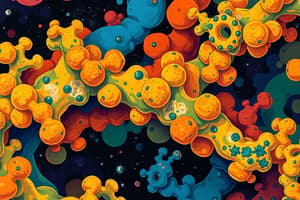Podcast
Questions and Answers
What is a simple sugar? Give examples.
What is a simple sugar? Give examples.
Monosaccharide; examples include glucose, mannose, and galactose.
What is a modified sugar?
What is a modified sugar?
Replacing a substituent on the ring with something more reactive.
What are oligosaccharides/polysaccharides?
What are oligosaccharides/polysaccharides?
Polymers of single sugars linked by glycosyltransferases.
What is the difference between glycoproteins and proteoglycans?
What is the difference between glycoproteins and proteoglycans?
What are the main characteristics of glycosylation?
What are the main characteristics of glycosylation?
What is glycosylation biosynthesis and why is it important?
What is glycosylation biosynthesis and why is it important?
How does glycosylation affect blood groups?
How does glycosylation affect blood groups?
Why is glycosylation important for pharmaceuticals?
Why is glycosylation important for pharmaceuticals?
How does erythropoietin depend on glycosylation?
How does erythropoietin depend on glycosylation?
How are glycoproteins degraded?
How are glycoproteins degraded?
What is a lysosomal storage disorder and what is an example?
What is a lysosomal storage disorder and what is an example?
What are some broad functions of proteoglycans?
What are some broad functions of proteoglycans?
What are the six classes of glycosaminoglycans (GAGs) and their common features?
What are the six classes of glycosaminoglycans (GAGs) and their common features?
What are the three major classes of proteoglycans in the extracellular matrix (ECM)?
What are the three major classes of proteoglycans in the extracellular matrix (ECM)?
What is Hyaluronate and what is its function?
What is Hyaluronate and what is its function?
What is Chondroitin Sulfate?
What is Chondroitin Sulfate?
What is Dermatan sulfate?
What is Dermatan sulfate?
How do heparin and heparin sulfate differ from other GAGs?
How do heparin and heparin sulfate differ from other GAGs?
What is important to know about Keratin Sulfate?
What is important to know about Keratin Sulfate?
What is Mucopolysaccharidosis and why are they important?
What is Mucopolysaccharidosis and why are they important?
How are proteoglycans degraded?
How are proteoglycans degraded?
What is the function of aggrecan in articular cartilage?
What is the function of aggrecan in articular cartilage?
Flashcards are hidden until you start studying
Study Notes
Simple Sugars
- Monosaccharides are basic sugars forming the building blocks of carbohydrates; examples include glucose, mannose, and galactose.
- D-glucose is a primary energy source for many organisms.
Modified Sugars
- Modified sugars involve substituting reactive groups on monosaccharides; for instance, hexosamines introduce nitrogen at C2, like d-galactosamine.
Oligosaccharides and Polysaccharides
- Polymers of monosaccharides such as lactose and maltose, which are formed through glycosidic bonds by glycosyltransferases.
- Decomposition is performed by glycosidases.
Glycoproteins vs. Proteoglycans
- Glycoproteins consist of proteins bound to carbohydrate chains, lacking repetitive sugar units.
- Proteoglycans feature glycosaminoglycan (GAG) chains attached to a protein core; they are primarily carbohydrate (95%) and commonly exhibit disaccharide repeat units.
Glycosylation Characteristics
- Glycosylation involves attaching carbohydrates to proteins, creating glycoproteins with short, branched chains (12-15 units) that enhance solubility.
Glycosylation Biosynthesis
- Involves N- or O-linked glycosylation, enhancing protein solubility and impacting vital biological processes like cell development and fertilization.
Blood Group Antigens
- Blood groups are determined by polysaccharide antigens on erythrocytes, influenced by glycosyltransferases; irregular glycosylation can be a disease biomarker.
Glycosylation in Pharmaceuticals
- Altered glycosylation of biological drugs can lead to adverse effects such as anaphylaxis; specific examples include Cetuximab and Herceptin.
Erythropoietin and Glycosylation
- Recombinant human erythropoietin (rhEPO) for treating anemia depends on N-glycosylation for functional activity.
Glycoprotein Degradation
- Glycoproteins are degraded by specific glycosidases, primarily in lysosomes, with malfunctioning enzymes leading to lysosomal storage diseases.
Lysosomal Storage Disorders
- Inherited enzyme defects result in substrate accumulation in lysosomes; symptoms include physical deformities and neurological decline. Example: Mucolipidosis II (I-Cell disease).
Functions of Proteoglycans
- Proteoglycans possess high anionic charge from uronic acids and sulfates, providing lubrication and structural support in connective tissues.
Classes of Glycosaminoglycans (GAGs)
- Primary GAGs include hyaluronic acid, chondroitin sulfate, dermatan sulfate, heparan sulfate, heparin, and keratin sulfate, with disaccharide repeats and sulfate groups.
Major Classes of Proteoglycans in ECM
- Categories include large aggregating proteoglycans (aggrecan), small leucine-rich proteoglycans, and basement membrane proteoglycans (perlecan).
Hyaluronate
- Non-sulfated GAG with disaccharide units, it serves as a lubricant and shock absorber, particularly in synovial fluid.
Chondroitin Sulfate
- Most abundant GAG, integral to cartilage and connective tissues, aggregates with hyaluronate.
Dermatan Sulfate
- Characterized by L-iduronic acid, commonly found in connective tissues such as skin and blood vessels.
Heparin and Heparan Sulfate
- Display unique disaccharide linkages; heparin acts as an intracellular anticoagulant and is involved in blood vessel functionality.
Keratin Sulfate
- Exists in two forms (KS I and KS II) and is linked to corneal and cartilage structures.
Mucopolysaccharidosis
- Genetic disorders leading to the accumulation of proteoglycan sugars, detectable prenatal; examples include Hurler's and Sanfilippo syndromes.
Proteoglycan Degradation
- Degraded via proteases and glycosidases.
Aggrecan in Articular Cartilage
- Functions as a structural element within cartilage, retaining water to provide compressive strength and facilitate smooth bone movement.
Studying That Suits You
Use AI to generate personalized quizzes and flashcards to suit your learning preferences.




